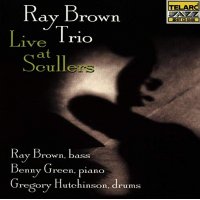Home » Jazz Articles » Album Review » The Ray Brown Trio: Live at Scullers
The Ray Brown Trio: Live at Scullers
Certainly one of the greatest trio cornerstones is Ray Brown. He has been "Mr. Rhythm Section" since the early 40s with Dizzy Gillespie's Big Band, through prominent associations with Ella Fitzgerald (as one-time husband and bassist), Oscar Peterson, Gene Harris, right through to his most recent trios with Benny Green on Telarc. It is here where we find Mr. Brown on his seventh Telarc Jazz release.
Ray Brown has had seven releases with Telarc since 1993 (and many more on Concord Jazz and other labels in previous years). Strictly speaking, these Telarc releases are not all "Trio" recordings. Some of My Best Friends are the Piano Players, Some of My Best Friends are the Sax Players, and Super Bass are all concept albums using Brown's standard trio as rhythm section and Seven Steps to Heaven adds a guitar to the trio mix. But make no mistake: Ray Brown drives all these musical buses, and his atomic sense of time is the thread that binds all of his recordings together.
The one thing that all of Brown's Telarc recordings have in common is Benny Green. A committed hard bopper and Oscar Peterson disciple, Green provides a perfect foil to Brown during this phase of Brown's career. The Drumming duties on these albums have been divided between Lewis Nash, Jeff Hamilton, and Gregory Hutchinson, who appears on the current recording.
Brown performs a mainstream repertoire, often playing pieces associated with other jazz performers. Miles Davis is one of the artists best represented in Brown's book. On Live at Scullers, Brown plays three songs long associated with Davis' 1950s quintet and sextet: a very cool "Freddie Freeloader," a ballad-paced "But Not for Me," and a straight-ahead "Bye, Bye Blackbird." These songs plus a wild and quirky "Whirlybird" make up the core of this disc. "Freddie Freeloader" has an extended introduction of Benny Green block chords and a brief Ray Brown obligatto before that Jimmy Cobb drumming from Kind of Blue emerges, perfectly executed by Hutchinson. It is a lively performance with Brown walking all the way through.
"But Not for Me" emerges as a surprise, slowly paced and thoughtful; quite a departure from the Miles performances (and Ahmad Jamal's, for that matter). It has an almost slow stride piano introduction. Played very much at a ballad pace, it really defies genre categorization: Benny's solo opens with an almost Gene Harris church-y quality and continues for the remainder of the piece, not really getting funky, but really adopting a hard hard-bop edge before returning to the languid pace of the introduction. Brown remains steadfast in his pacing of the piece, sounding very much like himself with a dash of Milt Hinton.
"Bye, Bye Blackbird" is another story. It is played pretty straight to the way one would have been used to hearing it from Miles. Brown has the introduction here. He has not lost his touch at all. Hutchinson brushes on this one, his high-hat pacing the song.
Neil Hefty's "Whirlybird" is a cornucopia of tempi, starting off pretty straight (one half expects the Atomic Mr. Basie's horns to roar in) before things start going wonderfully haywire. Green's block chords make this song sound less orchestral and more basic. After the straight introduction, the band goes into a triple or quadruple time survey of the chord progression with Green 16th, 32nd, and 64th notes. It is a fun romp.
This is a solid and well performed trio session. Ray Brown is one of the few remaining performers who were present during the gestation, birth, and life of be-bop. His sensibilities lie there. What Richard Cook and Brian Morton in The Penguin Guide to Jazz on CD, LP, and Cassette said of Gene Harris could just as easily been applied to Ray Brown: "[He] is always going to end up making the same record, but so far it still sounds pretty good." Amen, that we will always have such musicians.
Track Listing
Freddy Freeloader; En Estate; You're My Everything; But Not For Me; Bye, Bye Blackbird; If You Only Knew; Whirlybird.
Personnel
Ray Brown
bass, acousticRay Brown: bass; Benny Green: piano; Gregory Hutchinson: drums.
Album information
Title: Live at Scullers | Year Released: 1997 | Record Label: Telarc Records
< Previous
Playin' Hooky
Comments
Tags
For the Love of Jazz
 All About Jazz has been a pillar of jazz since 1995, championing it as an art form and, more importantly, supporting the musicians who create it. Our enduring commitment has made "AAJ" one of the most culturally important websites of its kind, read by hundreds of thousands of fans, musicians and industry figures every month.
All About Jazz has been a pillar of jazz since 1995, championing it as an art form and, more importantly, supporting the musicians who create it. Our enduring commitment has made "AAJ" one of the most culturally important websites of its kind, read by hundreds of thousands of fans, musicians and industry figures every month.



















